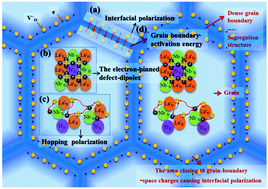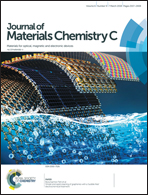The effect of segregation structure on the colossal permittivity properties of (La0.5Nb0.5)xTi1−xO2 ceramics†
Abstract
The newly discovered colossal permittivity (CP) TiO2 ceramics continue to arouse considerable interest owing to their applications in the field of high-performance capacitors. Here this work broadens the CP TiO2 systems to report the (La0.5Nb0.5)xTi1−xO2 (x = 0.01, x = 0.02, x = 0.03, x = 0.05, and x = 0.10) ceramics. The microstructure of the grain-boundary segregation has been found and the relationship between the segregation structure and dielectric properties has been established. The impedance spectroscopy analysis suggests that the segregation structure can increase the grain-boundary activation energies, which can be responsible for the effective suppression of long electron transfer to maintain a low loss and improve the temperature stability. However, the excessive segregation second phase can cause the deterioration of the dielectric properties. The analyses of the variable dielectric response with polarizable activation energies clearly indicate that the CP mechanism can be a combination of electron-pinned defect-dipoles, hopping polarization and interfacial polarization. More importantly, the comparisons of the polarizable activation energies under different amounts not only reveal that the deterioration of dielectric properties can be caused by the accessorial interfacial polarization by the excessive segregation second phase, but also can be an exact evaluation of the contribution of the segregation structure on the dielectric properties. The co-doping amount x = 0.03 provides the maximum beneficial effect of the segregation structure, embodied by the optimal performance with the highest permittivity (εr = 49 692), effective control of loss to maintain it at a low level (tan δ = 0.02896) and the best temperature stability (ΔC/C−50 to 150°C ≤ ±5.84). We believe this work enriches the theory on the co-doping TiO2 system and provides comprehensive guidance for methods to maintain the low loss of CP materials.



 Please wait while we load your content...
Please wait while we load your content...